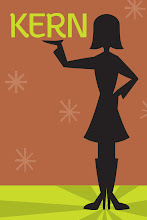
Once a month, brightly colored piles of paper bound together invade my home. Some are beautiful pieces of design, some are most definitely not. What they all have in common however, is the ability to make me want to put down whatever I'm working on to open up the pages and read them. Seriously, it doesn't matter if I'm grading student work, creating a new design for a client or cooking dinner; the magazine wins out almost every time. Am I addicted to them? Perhaps. Could I live without them? I'd like to think so but deep down inside I know I can't. So why are magazines so special?
Unlike other sources of media, magazines are the one thing I can read at my own pace and time. Television (not counting Tivo or DVR) is a must-watch-it-now medium as is radio, well must-listen. Web reading can be similar in that while the content may still be there tomorrow, it's likely now buried underneath something else. And newspapers you ask? Ever try to read one while snuggled under a blanket on the couch with a cup of tea in one hand? I rest my case. Magazines are perfect. They come regularly so therefore never end like a book, information inside is constantly changing though I can still find my favorite departments every month and the artistic look can vary not only from month to month but from page to page.
My household receives a plethora of magazines. As a design professional and educator, I receive
Print, Communication Arts, HOW, CMYK, Archive and
Metropolis magazines. As a Mac geek, I receive
MacWorld and as someone who likes general interest reading as well, I receive
Shape and
Real Simple. Other magazines that come into this house include
Smithsonian and
American Heritage. (Please note: I already admitted I am addicted to them.)
I like each and every one for different reasons. By far my favorite when it comes to design is
Real Simple. It's a large format magazine about making life simpler and more functional ("life made easier" is the tag line) and is printed on a beautiful paper that makes just touching the magazine pleasurable. The editorial content is geared to middle class readers who want the touch of the elegant and upscale without having to spend celebrity-sized budgets. The information is practical and interesting. I'm surprised and eager to find out what it includes when I receive it. Everything from good exercises for belly bulge to unique and functional ways of better organizing your office to packing more efficiently when traveling by air. It makes me want to read it. Every single page of it. The photography is gorgeous and elegant yet obtainable which makes me, as the general consumer, not feel like an outsider looking through it as some fashion magazines tend to do. Full color images are married with with white text to create non-intrusive captioning. Articles lead with interesting photo shoots that catch my eye as I flip through. The type is clean, sophisticated, well leaded and well kerned (And I'm damn picky when it comes to kerning). Every page has more than adequate white space to keep it from feeling cluttered and the system used for denoting departments is quite clear making it an easy task to find what I'm looking for. The color palette is clean and sophisticated and supports the upscale feeling of the magazine well, often complimenting a corresponding photograph. The color palette is also limited so it never makes me feel like I'm browsing through a rainbow. In addition to the above, the magazine has a very clear grid system making the ease of readability high. It's not a stuffy magazine though. It's comfortable feeling, kind of like how a good friend's conversation would look and feel. Kudos to their design staff on such a beautiful and successful magazine.
As for the other magazines, I could rank them in order of design preference, content preference, ease of use, etc. but I think it does them a disservice as they are each unique. As I say often, design is subjective and I am but one designer. What I can say about them is objectively they work. I have no trouble reading them, no trouble working my way through the magazine and no trouble accessing the information I want. I feel the magazines I listed above also communicate well to their intended audience. The design magazines communicate to designers and
Smithsonian and
American Heritage communicate to history and science buffs respectively. Regardless of the magazine type, the key is sell it. If the magazine draws your attention and compels you to buy it, the job is done.
So the question then becomes why do you buy it? Is it the subject matter? The look? The features? The art? Your reasons may vary as much as the variety of magazines available, but think about it. I've already named my favorite magazine and the reasons why. Take a look at your favorite magazine. Not just look through it though, really look AT it. Look at the type, the imagery, the departments, the cover, the table of contents, the features, etc. Why do you like it so much? Analyze it more than "it looks cool" or "I read it for the articles".












